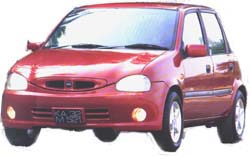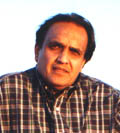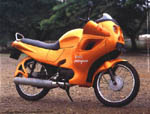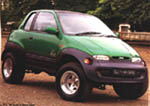The man, the machine
By Mohini Bhatnagar | 26 Feb 2000
 become cute and cuddly, or macho, or even sexy. In keeping with the persona he develops, he gives individual identities to his cars. For instance, a customised Esteem redesigned to become a rounded ‘soft and cuddly’ two-seater roadster is called Arka, while a customised Cielo becomes a macho Cielo Vampire.
become cute and cuddly, or macho, or even sexy. In keeping with the persona he develops, he gives individual identities to his cars. For instance, a customised Esteem redesigned to become a rounded ‘soft and cuddly’ two-seater roadster is called Arka, while a customised Cielo becomes a macho Cielo Vampire. Taking the chassis and engine of any car, say a Cielo, he institutes changes -- depending on the client’s requirements -- in the grille, bumper, mudguard, headlights, taillights, bonnet, wheels, the interiors, the top... The finishing touch: a superb paint job. Ultimately, depending on the extent of the customisation, a client could end up with his vehicle that looks totally unlike its former self, or have a few changes that makes it stand apart.
If Dilip Chhabria, 46, transportation design engineer from the Institute of Automobile Design, Berkeley, California, USA, was always clear about one thing, it was that he needed to make his mark as an automobile designer. Perhaps the reason why he chose to resign from a cushy job as an auto designer at General Motors Co., USA, after just one year of working there. In his words: "There was no opportunity for me to grow in an organisation where there were 1,500 designers and I was one of them. I realised that it would be a long haul for me to reach the stage of designing even a part of a car."
Institute of Automobile Design, Berkeley, California, USA, was always clear about one thing, it was that he needed to make his mark as an automobile designer. Perhaps the reason why he chose to resign from a cushy job as an auto designer at General Motors Co., USA, after just one year of working there. In his words: "There was no opportunity for me to grow in an organisation where there were 1,500 designers and I was one of them. I realised that it would be a long haul for me to reach the stage of designing even a part of a car."
Thereafter, on one of his trips home to India where his father had an electrical parts business, he decided to set up his own automobile spare parts and accessories business using his father’s business premises. Ten years – 1982 to 1992 -- was the time it took for him to become one of, as he says, "the largest auto accessories manufacturer in the country." After which there was again a vacuum. In fact, Chhabria felt he was furthest away from his passion—cars—than he had ever been. Being an auto accessories maker was not like being part of the automobile industry.
By this time, he says, he had built up a rapport with automobile manufacturers Mahindra & Mahindra as he had been doing some redesign jobs for them. With the support of M&M, DC Design, a car redesign unit, was instituted in 1993. Beginning with 13 employees, an investment of Rs 20 lakh and his own intellectual capital, DC Design was more of a hobby shop for Chhabria initially, where he maintained his own cars, tinkered around with friends’ cars and did whatever redesign jobs came his way. At this time, his only consideration was that he should break even.
some redesign jobs for them. With the support of M&M, DC Design, a car redesign unit, was instituted in 1993. Beginning with 13 employees, an investment of Rs 20 lakh and his own intellectual capital, DC Design was more of a hobby shop for Chhabria initially, where he maintained his own cars, tinkered around with friends’ cars and did whatever redesign jobs came his way. At this time, his only consideration was that he should break even.
The few redesign jobs that came his way got him more jobs and soon his ‘hobby shop’ developed into a leading design outfit. Cars customised by Chhabria come at a whopping price and he admits that by conservative estimates, a complete redesigning job can add a cost equal to the price of the original car. For instance, the price of a redesigned Maruti Esteem is likely to vary between Rs 10 lakh and Rs 11 lakh.
Chhabria shrugs off the issue of his pricing by saying, "My cars are not for the first time buyer, nor for the second or the third. They are for the fifth or sixth time buyers who want to use their car to make a personality statement." He explains that he has used his creations over the years to showcase his talent as an automobile designer.
Agreeing that redesigning and customising single cars is a grossly expensive proposition, he says, "Very early on, I decided I would showcase my abilities through my creations. The only thing I needed were people who were willing to pay for them." As it turned out, there were many who were not only willing to pay, but wanted more of his creations.
Over the years, his strategy has paid off well, the latest feather in his cap being a contract with Ford Motor India to design cars for it. Apart from redesigning cars, Chhabria also styles and refurbishes coach interiors for corporate houses or film production units. This, he says, has always been his leading source of income, or "bread and butter," as he puts it.
Things have gradually changed at DC Design. While the market for redesigned cars may be limited, there are a growing number of car owners who want to stamp their cars with a touch of personal appeal. This has prompted Chhabria to manufacture ready-made body kits and distribute them all over the country via auto dealers and spare parts shops who, in turn, can sell them to anyone irrespective of geographic constraint. Some of the cars of which body kits are available are: Hyundai Santro, Mitsubishi Lancer, Tata Sierra, Fiat Uno, Tata Safari, Tata Sumo, Tata Indica and Maruti Esteem. These are now available in about 30 outlets in all, in the cities of Mumbai, Delhi and Bangalore. Apart from four wheeler body kits, Chhabria’s two-wheeler kits are also much in demand.
personal appeal. This has prompted Chhabria to manufacture ready-made body kits and distribute them all over the country via auto dealers and spare parts shops who, in turn, can sell them to anyone irrespective of geographic constraint. Some of the cars of which body kits are available are: Hyundai Santro, Mitsubishi Lancer, Tata Sierra, Fiat Uno, Tata Safari, Tata Sumo, Tata Indica and Maruti Esteem. These are now available in about 30 outlets in all, in the cities of Mumbai, Delhi and Bangalore. Apart from four wheeler body kits, Chhabria’s two-wheeler kits are also much in demand.
Plans are to turn DC Design into an automotive design company on the lines of Italian car designers. Already, the name of the company has been changed from DC Design to DC Design (Automotive) Pvt Ltd. in April 1999. Fifteen per cent of its equity has been divested to venture capital funds.
And coming out of its new focus as an automotive design company has been L’il, the first car manufactured by DC Design (Automotive) Pvt Ltd. Chhabria is flushed with the success of this 600cc, 28 bhp small car, recently unveiled at the Auto Expo 2000, held in New Delhi recently. The response apparently was overwhelming enough for him to consider offering it in the Indian market. L’il, he says, was designed and manufactured for a global auto firm, the name of which is kept under wraps for the moment, but was showcased at the Auto Expo to gauge public response.
A designer who once preferred free-hand drawing to the modern day mouse, Chhabria now has a computer aided design (CAD) unit, which lends engineering design capability to the company. Li'l was designed here, with Chhabria introducing an engine and chassis for the first time, unlike his earlier jobs where these were the manufacturers’.
Chhabria positions L’il between two-wheelers and cars, as a four-wheeler capable of seating three abreast. The car is expected to be priced at Rs 1.5-1.6 lakh. Planned for diesel, petrol and electric versions, L’il reportedly touched 85-90 km/hr in trial runs with a mileage of 35 km/litre of diesel. Rather squarish in dimension, L’il is said to be stable. But comprehensive testing is yet to happen.
"Funds aren't a handicap to DC's growth any longer,'' Chhabria says. Projected turnover for 1999-2000 is Rs 1.5 crore, and rising sharply on the strength of two- and four-wheeler kit sales, turnover for the next fiscal is expected to touch Rs 6 crore.
Dilip Chhabria’s business plan now includes a domestic initial public offering by October 2000 and eventually, a Nasdaq listing. Venture capitalists and the choice of Nasdaq as the bourse for listing reflect favourable times for a company driven so far by its promoter's intellectual capital.






















